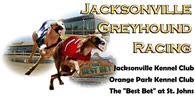 AAGA currently gets almost all of its Greyhounds from the Jacksonville – Orange Park racing circuit in northeastern Florida through the adoption program supported by the track and the kennels that race there.
AAGA currently gets almost all of its Greyhounds from the Jacksonville – Orange Park racing circuit in northeastern Florida through the adoption program supported by the track and the kennels that race there.
Greyhounds begin professionally racing at approximately 2 years of age. Their racing career ends when they are no longer competitive. This could be due to injury, poor racing behaviors, or the fact that they are just not fast enough. Most of the Greys that come to us are 2 to 4 years old.
To better understand the complicated transition that an ex-racer must make from being a working athlete to a home companion, it is helpful to know something about his former life.
 The Greyhound’s life begins on a breeding farm, where a great deal of planning has first gone into the pedigree of a litter. Racing Greyhounds in the U.S. are not AKC dogs; they are registered by the National Greyhound Association (NGA). Show Greyhounds are registered by the AKC, but they are relatively rare.
The Greyhound’s life begins on a breeding farm, where a great deal of planning has first gone into the pedigree of a litter. Racing Greyhounds in the U.S. are not AKC dogs; they are registered by the National Greyhound Association (NGA). Show Greyhounds are registered by the AKC, but they are relatively rare.
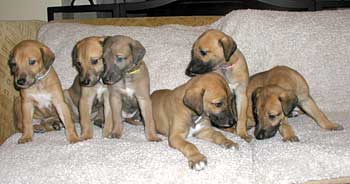 Puppies are kept with their mother until they are weaned at about 8 to 9 weeks of age. At that time, usually with the
Puppies are kept with their mother until they are weaned at about 8 to 9 weeks of age. At that time, usually with the 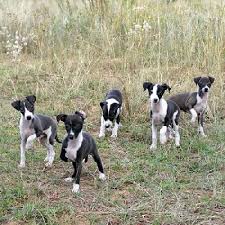 litter remaining intact, they are moved to pens with outdoor runs where they are allowed to exercise as much as they want. They are given toys to encourage the chasing instinct. They are fed a mixture of dry meal and meat three times a day. Sometime over the next month or so their ears will be tattooed with their permanent identifying numbers.
litter remaining intact, they are moved to pens with outdoor runs where they are allowed to exercise as much as they want. They are given toys to encourage the chasing instinct. They are fed a mixture of dry meal and meat three times a day. Sometime over the next month or so their ears will be tattooed with their permanent identifying numbers.
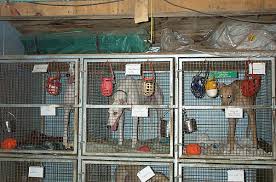 At 10 months of age the pups are sent to a rearing facility where they are introduced to a collar and leash and begin serious schooling to prepare them for racing. Here they also learn to adapt to the more formal living environment of kennel life where wire crates (perhaps 40 to 60) are stacked two high per room, generally with females on the upper row. And life now becomes one of strict routine.
At 10 months of age the pups are sent to a rearing facility where they are introduced to a collar and leash and begin serious schooling to prepare them for racing. Here they also learn to adapt to the more formal living environment of kennel life where wire crates (perhaps 40 to 60) are stacked two high per room, generally with females on the upper row. And life now becomes one of strict routine. 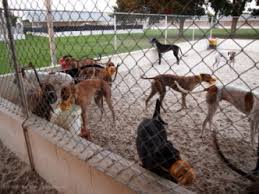 They are “turned out” four times a day, during which time they can relieve themselves and play with other kennel mates while trainers and helpers interact with them and tidy up the kennel. (Greyhounds rarely mess in their personal living space.) While outside in the turnout pens, the dogs are muzzled to prevent any confrontations with their fellow hounds.
They are “turned out” four times a day, during which time they can relieve themselves and play with other kennel mates while trainers and helpers interact with them and tidy up the kennel. (Greyhounds rarely mess in their personal living space.) While outside in the turnout pens, the dogs are muzzled to prevent any confrontations with their fellow hounds.
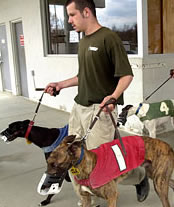 Twice a week the Greyhounds are taken to a training track where they are exercised, introduced to the artificial lure and the starting box, and trained to run on a circular track. At approximately 18 months of age they are permanently moved to a racetrack to begin preparing for professional races.
Twice a week the Greyhounds are taken to a training track where they are exercised, introduced to the artificial lure and the starting box, and trained to run on a circular track. At approximately 18 months of age they are permanently moved to a racetrack to begin preparing for professional races.
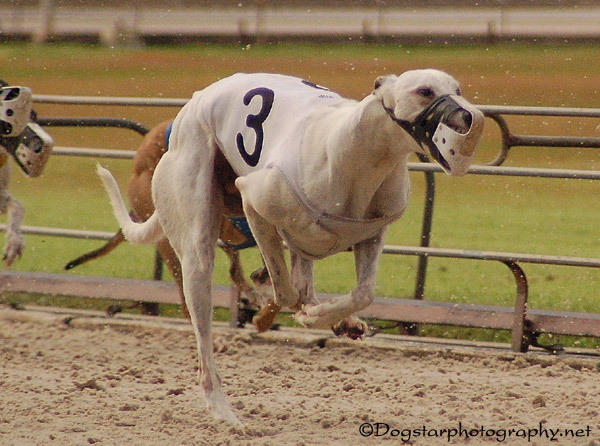 Greyhounds have been clocked at speeds of up to 45 mph, second only to the Cheetah as the world’s fastest animal. Generally, the dogs race once or twice a week, with most races lasting 30 seconds. Races are mixed, with males and females running together. Females are kept on testosterone to keep them from coming into heat. Races are divided into grades, with the dogs moving up and down through these
Greyhounds have been clocked at speeds of up to 45 mph, second only to the Cheetah as the world’s fastest animal. Generally, the dogs race once or twice a week, with most races lasting 30 seconds. Races are mixed, with males and females running together. Females are kept on testosterone to keep them from coming into heat. Races are divided into grades, with the dogs moving up and down through these 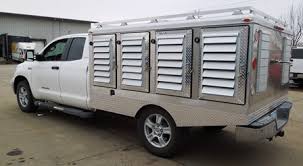 levels throughout their career based on their performance. The difference between the speed of a Grade A Greyhound and a Grade D one can be as little as 1/4th of a second. The dogs may also be moved from one track to another depending on racing seasons and performance.
levels throughout their career based on their performance. The difference between the speed of a Grade A Greyhound and a Grade D one can be as little as 1/4th of a second. The dogs may also be moved from one track to another depending on racing seasons and performance.
While some owners have little or no contact with the dogs, viewing them merely as investments, most owners either run their particular Greyhounds in their own racing kennel or lease them to other racing kennels. These owners are in constant contact with the kennel operators and trainers racing their Greyhounds to ensure that their hounds 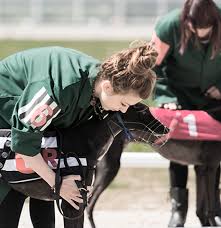 receive proper care and training. While racing, the dogs have their closest relationships with their trainers (a large portion of whom are women), and it is generally the trainer who determines (and advises the owner) when a Greyhound’s career is over, whether it be due to a lack of interest in racing, an injury, or just poor performance. And that can happen as early as age 2.
receive proper care and training. While racing, the dogs have their closest relationships with their trainers (a large portion of whom are women), and it is generally the trainer who determines (and advises the owner) when a Greyhound’s career is over, whether it be due to a lack of interest in racing, an injury, or just poor performance. And that can happen as early as age 2.
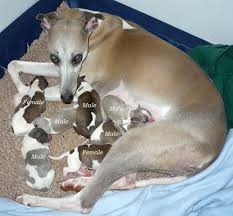 If a Greyhound has had an extremely successful career on the track, he/she may be used for breeding. If the Greyhound isn’t used for breeding and doesn’t compete at another racetrack, Greyhound racetracks are required, by contract, to place the dog in a certified adoption program or return it to the original owner.
If a Greyhound has had an extremely successful career on the track, he/she may be used for breeding. If the Greyhound isn’t used for breeding and doesn’t compete at another racetrack, Greyhound racetracks are required, by contract, to place the dog in a certified adoption program or return it to the original owner.
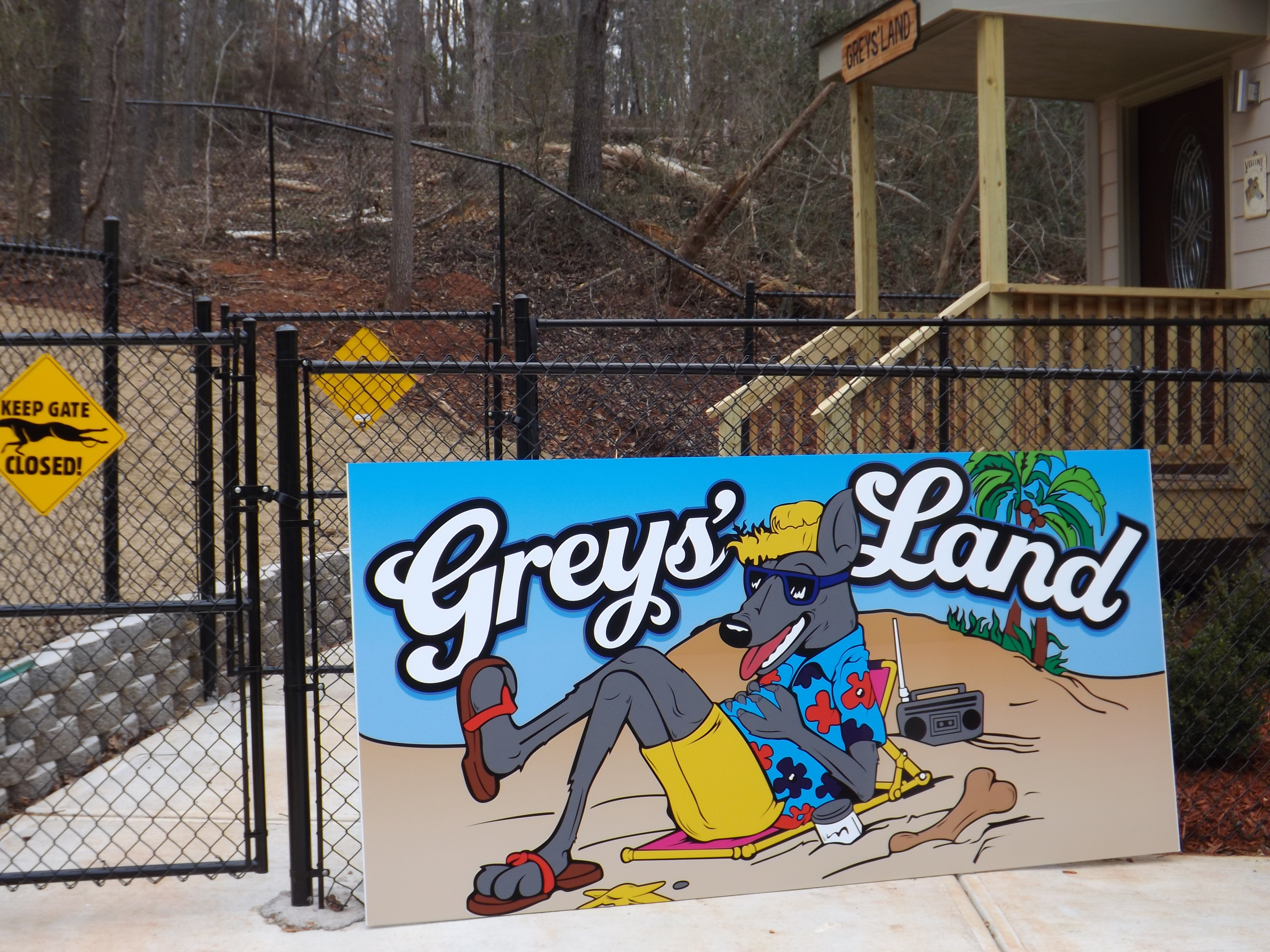 The early 1980’s saw the rise of the Greyhound adoption movement to find homes for retired racers as pets. Currently, there are over 200 such dedicated organizations located throughout the country. Also, in recent years the racing industry has made significant progress in establishing programs for the adoption of retired racers. In addition to actively cooperating with private adoption groups, many racetracks have established their own adoption programs. The adoption program from where AAGA gets its Greyhounds is supported by the racetrack and the kennels that race there, as well as private donations.
The early 1980’s saw the rise of the Greyhound adoption movement to find homes for retired racers as pets. Currently, there are over 200 such dedicated organizations located throughout the country. Also, in recent years the racing industry has made significant progress in establishing programs for the adoption of retired racers. In addition to actively cooperating with private adoption groups, many racetracks have established their own adoption programs. The adoption program from where AAGA gets its Greyhounds is supported by the racetrack and the kennels that race there, as well as private donations.
 Greyhound racing reached its highest popularity after the Second World War (1946). However, it has been in a steady decline since the early 1960’s, as the expansion of casino gambling has greatly decreased its profitability. The profitability is also thought to decline even more so with people being able to gamble online at the many online casino options now available. In 2000 there were 50 tracks in 15 states. Tn 2015 there were 21 tracks in 7 states – Alabama, Arizona, Arkansas, Florida, Iowa, Texas and West Virginia. Florida, with its 12 tracks, remained the seat of the industry and the major source of adoptable ex-racers until 2021 when Greyhound racing was declared virtually illegal and all tracks were closed.
Greyhound racing reached its highest popularity after the Second World War (1946). However, it has been in a steady decline since the early 1960’s, as the expansion of casino gambling has greatly decreased its profitability. The profitability is also thought to decline even more so with people being able to gamble online at the many online casino options now available. In 2000 there were 50 tracks in 15 states. Tn 2015 there were 21 tracks in 7 states – Alabama, Arizona, Arkansas, Florida, Iowa, Texas and West Virginia. Florida, with its 12 tracks, remained the seat of the industry and the major source of adoptable ex-racers until 2021 when Greyhound racing was declared virtually illegal and all tracks were closed.
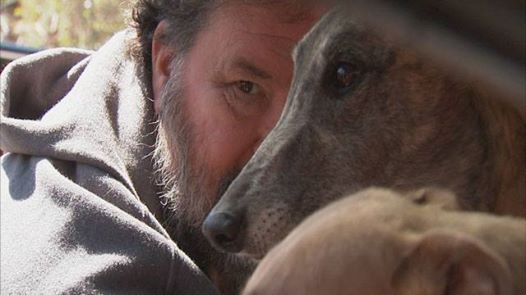 Each year there are fewer Greyhounds being bred and whelped, as there are fewer Greyhound racetracks remaining operable. Currently, it is very difficult to find retired racing Greyhounds available for adoption as pets. Since almost all our Greyhounds came from Florida racetracks, Adopt A Greyhound Atlanta no longer is able to acquire ex-racers for re-homing. We remain, however, as a support organization for our many adopters and the Greyhound community in general.
Each year there are fewer Greyhounds being bred and whelped, as there are fewer Greyhound racetracks remaining operable. Currently, it is very difficult to find retired racing Greyhounds available for adoption as pets. Since almost all our Greyhounds came from Florida racetracks, Adopt A Greyhound Atlanta no longer is able to acquire ex-racers for re-homing. We remain, however, as a support organization for our many adopters and the Greyhound community in general.
For a Greyt series of images depicting “A Day in the Life of a Racing Greyhound” by photographer, Rachel Hogue, check out this site:
https://m.flickr.com/#/photos/dazzleme/sets/72157627145032411
